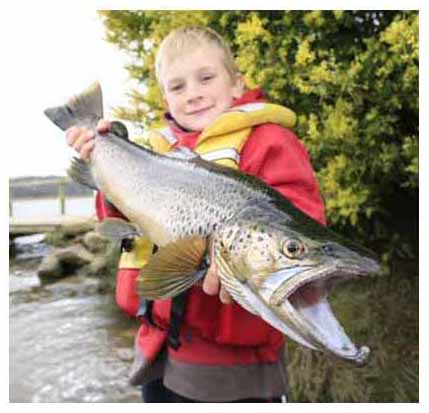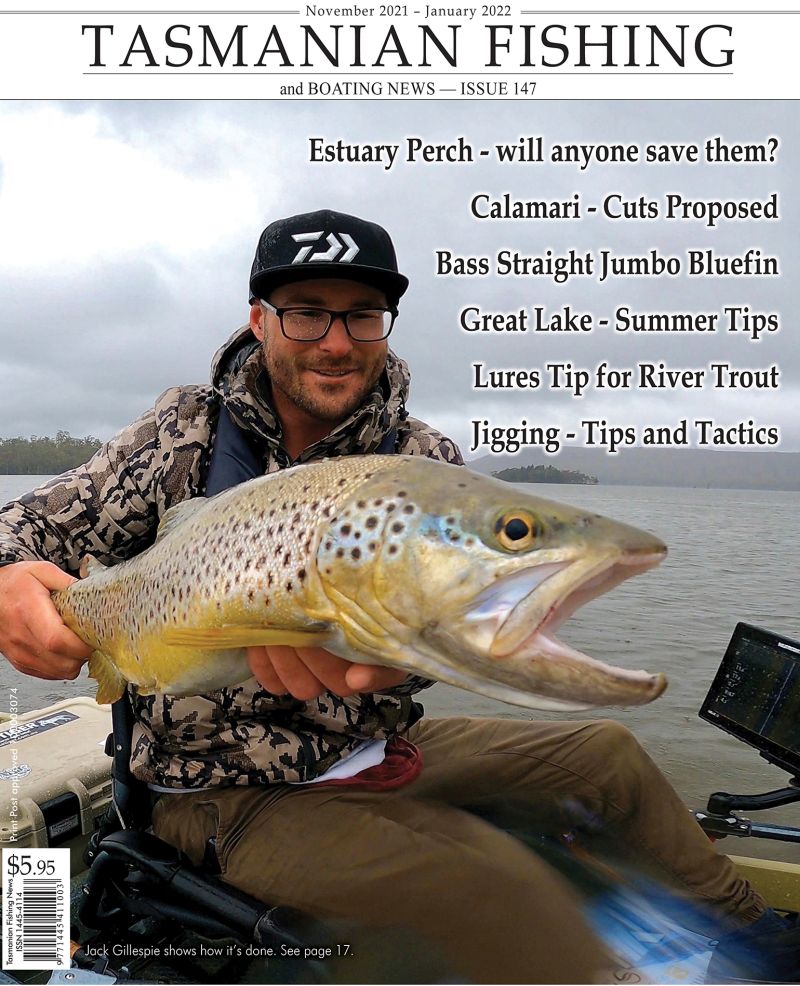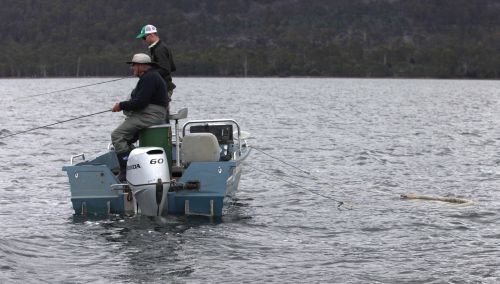From the Archives ...
Sea run trout tactics – Craig Vertigan
Sea run trout tactics – Craig Vertigan
During the trout off-season I tend to spend a bit of time chasing bream, to continue getting a fishing fix, and spend time tying flies and dreaming about the trout season to come. It’s a time to spend doing tackle maintenance, stocking up on lures and dreaming up new challenges and goals for the trout season ahead. When the new season comes around I usually spend the first few months targeting sea runners. Sea run trout are simply brown trout that spend much of there lives out to sea and come in to the estuaries for spawning and to feed on whitebait and the other small endemic fishes that spawn in late winter through spring. Mixed in with the silvery sea runners you can also expect to catch resident fish that have the typical dark colours of a normal brown trout as well as atlantic salmon in some of our estuaries that are located near salmon farm pens. Living in Hobart it is quick and easy to do a trip on the Huon or Derwent and is a more comfortable proposition compared to a trip up to the highlands with snow and freezing winds to contend with.
Read more ...Please check all relevant authorities before fishing - www.ifs.tas.gov.au and dpipwe.tas.gov.au . Don't forget issuu.com/stevenspublishing for years of back issues !
Trolling for flathead - a proven method
by Phillip Ellerton
Try something different: Flathead on the troll. Your average angler has caught a flathead on bait. We've all done it before, a relaxing afternoon catching enough flathead for friends and family.
- Category: Saltwater and Estuary Fishing
- Hits: 9698
Hooks - Part one
by Andrew Hart
When you think about it, a hook is one of the cheapest and most important parts of fishing. If you don't have a hook, then chances are you won't catch too many fish!
- Category: Tackle, Boats and other Equipment
- Hits: 5596
Looking at lures
by Michael Bok
Soft plastic lures are some of the cheapest lures that can be brought and are every bit as good as any other more expensive variety of lure.
- Category: Tackle, Boats and other Equipment
- Hits: 7348
Winter trout fishing in the Derwent Estuary
by Greg French
The Derwent, the truly great winter trout fishery on Hobart's doorstep, remains under fished. There are several reasons: The River Derwent down stream of Dogshear Point (Cadbury Point) is not an official "˜inland water"and so it is not subject to normal Inland Fisheries regulations.
- Category: Derwent River
- Hits: 11670
Best Baits - Mussels
Part one in a series, by Phil Ellerton, on the best baits to use in Tasmanian waters.
- Category: Tackle, Boats and other Equipment
- Hits: 10371
Winter fishing in the Tamar River
Steve Suitors home overlooks one of his favourite fisheries - the Tamar River. Steve points out that there is no need to pack the gear up just because it is cold. The Tamar River offers many opportunities for winter fishing.
- Category: Tamar River
- Hits: 22665
Tasmanian's South West Australia's undiscovered frontier
Rod Green of South West Adventure Tours the Strahan area on the West Coast.
Great fishing, variety and spectacular scenery is what awaits any fisherman and their families venturing into the West coast.
- Category: Saltwater and Estuary Fishing
- Hits: 6862
Read more: Tasmanian's South West Australia's undiscovered frontier
 Four Springs
Four Springs
Four Springs is one of the very few, angler initiated, dedicated public fisheries.In fact I can't think of any other waters that were built by anglers, for anglers that are public. It is a great credit to those that put in the work and it is one of our best Tasmanian waters - especially in the early part of the season when the highlands can be so cold and uninviting.
- Category: Four Springs
- Hits: 10995
Harts Hints - Maintaining your fishing tackle
by Andrew Hart
You have spent money on the best gear you can afford, and you expect it to perform each and every time you use it. However, after a while the salt, and the sand start to eat away at your very expensive reel, or brand name knife, and before you know it, your gear is old and useless.There are ways to maintain your tackle, and with just a bit of extra effort, your gear can last many years.
- Category: Tackle, Boats and other Equipment
- Hits: 5478
Kermandie River makes a come back
by Andrew Lawson
This waterway is found in the Southern region of the Island in and around the town of Geeveston. It has two main sources that originate from Rileys Creek reservoir constructed for the purpose of the town's water supply and the Kermandie river itself from below the falls.
- Category: Other Rivers
- Hits: 11645
Subcategories
Current TFBN
Click above for current issue content. The current issue of TFBN is extensive and topical. In Tackle Stores, Newsagents and by subscription.
Delivered to your door for $48 for 2 years (8 issues). To subscribe, send Mike $48 via www.paypal.com.au . (Basic instructions are here) The email is at Contact Us. Your address will be included from PayPal.
Or phone Mike with your c/c handy on 0418129949
Please ensure your details are correct, for Mike to organise delivery.
TFBN Newsletter Sign up Form
Why not submit an article ?
When you have finished for the day, why not have a brag about the ones that didn't get away! Send Mike an article on your fishing (Click here for contact details), and we'll get it published here. Have fun fishing - tasfish.com
Category Descriptions
Here is a list of all of the Article Categories. The number in Brackets, eg (13) is the number of articles. Click on Derwent River and all articles relating to the Derwent will be displayed in the central area.
Articles by Category
-
Rivers (3)
-
Saltwater and Estuary Fishing (149)
-
Kayak Fishing (34)
-
Lakes (1)
-
Great Lake (62)
-
Lake Leake (52)
-
Woods Lake (16)
-
Lake Augusta (11)
-
Huntsman Lake (13)
-
Lake Pedder and Gordon (10)
-
Lake Dulverton (5)
-
Lake Crescent (6)
-
Tooms Lake (10)
-
Lake Mackintosh (2)
-
Lake Barrington (5)
-
Little Lake (8)
-
Meadowbank Lake (5)
-
Lake King William (7)
-
Lake St Clair (2)
-
Western Lakes (12)
-
Arthurs Lake (35)
-
Lake Echo (7)
-
Four Springs (54)
-
Lake Sorell (7)
-
Lake Burbury (6)
-
Other Lakes (57)
-
Brushy Lagoon (18)
-
Little Pine Lagoon (5)
-
Penstock Lagoon (16)
-
Brumbys Creek (7)
-
-
Events (48)
-
Estuary Fishing (0)
-
Coastal Catches (46)
-
Super Trawler (46)
-
IFS, DPIPWE, MAST and Peak Bodies (435)
-
Commercial Interests (98)
-
Other (24)
-
TFBN Back Issues (8)
-
Fly Fishing (67)
-
Trout Fishing (250)
-
Meteorology and Weather (8)
-
Jan’s Flies (50)
-
Tuna Fishing and other Game Fishing (86)
-
Cooking Fish (19)
-
Fishing Information (1)
-
Fishing Books (8)
-
Videos (5)
-
Tackle, Boats and other Equipment (146)
-
World Fly Fishing Championship 2019 (2)
Popular Tags
windyty.com
Visit https://www.windyty.com/
Rubicon Web and Technology Training
Hello everyone, I thought it would be a good time to introduce myself.
My name is Stephen Smith and I have been managing the website tasfish.com since May 2009.
It has been an epic journey of learning and discovery and I am indebted to Mike Stevens for his help, support and patience.
I am developing a new venture Rubicon Web and Technology Training ( www.rwtt.com.au ). The focus is two part, to develop websites for individuals and small business and to train people to effectively use technology in their everyday lives.
Please contact me via www.rwtt.com.au/contact-me/ for further information - Stephen Smith.
From the Archives ... (last chance)
Sea run trout tactics – Craig Vertigan
Sea run trout tactics – Craig Vertigan
During the trout off-season I tend to spend a bit of time chasing bream, to continue getting a fishing fix, and spend time tying flies and dreaming about the trout season to come. It’s a time to spend doing tackle maintenance, stocking up on lures and dreaming up new challenges and goals for the trout season ahead. When the new season comes around I usually spend the first few months targeting sea runners. Sea run trout are simply brown trout that spend much of there lives out to sea and come in to the estuaries for spawning and to feed on whitebait and the other small endemic fishes that spawn in late winter through spring. Mixed in with the silvery sea runners you can also expect to catch resident fish that have the typical dark colours of a normal brown trout as well as atlantic salmon in some of our estuaries that are located near salmon farm pens. Living in Hobart it is quick and easy to do a trip on the Huon or Derwent and is a more comfortable proposition compared to a trip up to the highlands with snow and freezing winds to contend with.
Read more ...


